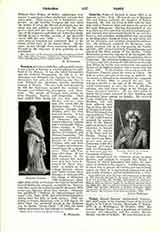

Tanagra, a titular see in Hellas, suffragan of Corinth; it was a town of Boeotia, in a fertile plain on the right bank of the Aesopus. It was also called Poemandria and its territory Poemandris. In 457 B.C. the Athenians were defeated near Tanagra by the Lacedaemonians, but early in the following year they in turn defeated the Boeotians, thereby becoming masters of Boeotia. The city walls were destroyed. In 426 the Athenians invaded the territory of Tanagra and defeated the Tanagrians and Boeotians. The people of Tanagra were noted for their frugality, loyalty, and hospitality. Their land yielded little wheat, but the best wine in Boeotia, and the town was also noted for its fighting-cocks. Under Augustus Tanagra and Thespiae were the chief towns of Baeotia. It had numerous temples, one of Dionysius with a famous statue by Calanus and a remarkable Triton, other temples of Themis, Aphrodite, Apollo, Hermes Criophorus, and Hermes Promaclius. The gymnasium contained a portrait of the poetess, Corinna, who was born at Tanagra and commemorated there by a monument. Pliny calls Tanagra a free state. It was still important in the sixth century, but must soon after have been destroyed by Slavic invasions. A station on the railway between Athens and Thebes is now called Tanagra; it connects with the village of Skimatari (650 inhabitants), about eight miles south of which are the ruins of the ancient town including the acropolis, necropolis etc. Excavations have made the tombs famous for the pretty little terra-cotta figurines which they contain. Duchesne has published (“Bulletin de correspondance hellénique”, III, Paris, 1879, 144) a Christian inscription dating from the fifth or sixth century. Only one bishop is known, Hesychius, who in 458 signed the letter from the provincial synod to the Emperor Leo (Le Quien, “Oriens Christ.”, II, 212); the other bishop mentioned by him belongs to another see.
S. PETRIDES

